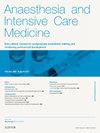Pain assessment in children
IF 0.3
Q4 ANESTHESIOLOGY
引用次数: 0
Abstract
Causes of childhood pain include peri-procedural, injury and disease. Systematic reviews have shown that pain can lead to anxiety, sleep disturbance, and have deleterious effects on daily life.
Experienced pain is influenced by biological, psychological and social factors. Pain assessment in children is particularly challenging due to the wide variation in physiological responses, communication abilities and developmental stages of this group of patients. For example, their limited verbal repertoire can lead to an under-recognition of pain as compared to adults who may be better able to articulate their pain.
Childhood pain has an effect in the short-term not only on the child but their carers. Long-term effects of unrecognized, undertreated or poorly managed pain can lead to important cognitive and behavioural consequences. This can lead to anticipatory anxiety and can lead to more difficulty in management of pain during future episodes of illness or future treatments.
Well-managed pain is associated with faster recovery, fewer complications and decreased health care resources. Regular assessment and documentation of pain, using appropriate tools for development age and ability, is essential in order to assess efficacy of pain treatments.
儿童疼痛评估
儿童期疼痛的原因包括围手术期、损伤和疾病。系统综述表明,疼痛会导致焦虑、睡眠障碍,并对日常生活产生有害影响。体验性疼痛受生理、心理和社会因素的影响。由于儿童在生理反应、沟通能力和发育阶段的广泛差异,对儿童疼痛的评估尤其具有挑战性。例如,与成年人相比,他们有限的语言能力可能导致对疼痛的认识不足,而成年人可能能够更好地表达他们的疼痛。儿童时期的疼痛在短期内不仅对孩子有影响,而且对他们的照顾者也有影响。未被认识、治疗不足或管理不善的疼痛的长期影响可导致重要的认知和行为后果。这可能会导致预期性焦虑,并可能导致在未来疾病发作或未来治疗期间更难控制疼痛。良好的疼痛管理与更快的恢复、更少的并发症和更少的卫生保健资源有关。定期评估和记录疼痛,使用适合发育年龄和能力的工具,对于评估疼痛治疗的疗效至关重要。
本文章由计算机程序翻译,如有差异,请以英文原文为准。
求助全文
约1分钟内获得全文
求助全文
来源期刊

Anaesthesia and Intensive Care Medicine
ANESTHESIOLOGY-
CiteScore
0.50
自引率
0.00%
发文量
152
期刊介绍:
Anaesthesia and Intensive Care Medicine, an invaluable source of up-to-date information, with the curriculum of both the Primary and Final FRCA examinations covered over a three-year cycle. Published monthly this ever-updating text book will be an invaluable source for both trainee and experienced anaesthetists. The enthusiastic editorial board, under the guidance of two eminent and experienced series editors, ensures Anaesthesia and Intensive Care Medicine covers all the key topics in a comprehensive and authoritative manner. Articles now include learning objectives and eash issue features MCQs, facilitating self-directed learning and enabling readers at all levels to test their knowledge. Each issue is divided between basic scientific and clinical sections. The basic science articles include anatomy, physiology, pharmacology, physics and clinical measurement, while the clinical sections cover anaesthetic agents and techniques, assessment and perioperative management. Further sections cover audit, trials, statistics, ethical and legal medicine, and the management of acute and chronic pain.
 求助内容:
求助内容: 应助结果提醒方式:
应助结果提醒方式:


